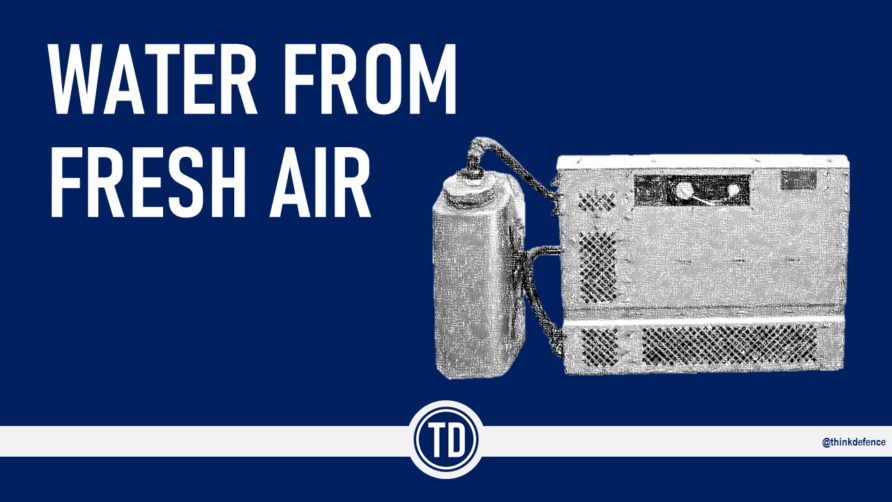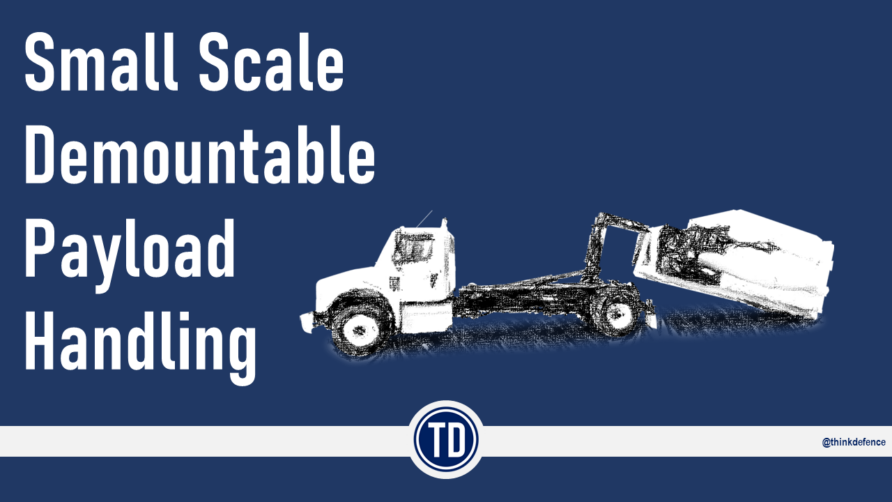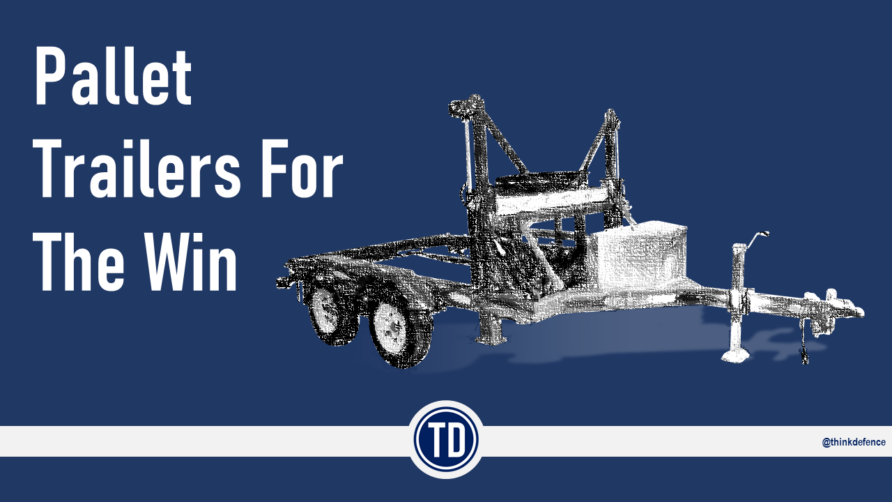The Expeditionary Elevated Causeway (ELCAS) is a remarkable portable modular structure that can be built out from the beach to a distance of 3,000 feet (0.91 km). It can also be built up to a depth of 20 feet (ca. 6 m) to allow small vessels to come alongside and discharge their cargo.
It is part of the US Department of Defense capability set called Logistics Over The Shore (LOTS), broadly defined as;
The process of loading and unloading of ships without the benefit of deep draft-capable, fixed port facilities; or as a means of moving forces closer to tactical assembly areas.
When Army and Navy LOTS operate together under a Joint Force Commander, LOTS becomes JLOTS.
The threat environment is described as;
Joint logistics over-the shore (JLOTS) operations are normally conducted in a low threat environment. Primary threats to consider are air and rocket attacks, attack by adversary ground forces, guerrillas or insurgents operating behind the lines, and sabotage. Chemical, biological, radiological, nuclear, and high-yield explosives warfare is considered possible.
Sea Basing was supposed to largely replace JLOTS; instead of anchoring ships close inshore and using D-Day era landing craft and pontoons, Sea Basing was high speed, largely airborne and of course costly. JLOTS on the other hand is in comparison, cheap as chips.
I get the impression that those in charge of JLOTS had a look at Sea Basing, realised it was all expensive nonsense and decided to carry on normal jogging
JLOTS is not for use when there is opposition in the area but then again, neither was the MPF(F). It is not very mobile and takes time to establish but when it does get going, throughput can be significant, unmatched by anything else.
One of the initial proving exercises, despite many disruptions due to higher-than-expected sea states, demonstrated an offload of over 800 containers and 1,300 vehicles in 14 days.
To do this required 67 different units, a total of 5,000 personnel, 70 small craft and a large onshore build.
Impressive, hell yes, especially when compared to the LCU/Mexeflote capability the UK enjoys but look again at those numbers.
5,000 personnel for a start, that is a significant ration strength to support and if replicated in the UK would represent nearly 7% of the total British Army regular strength. 800 containers in two weeks, as a comparison, London Gateway can handle about 125,000 containers in the same period
Its principal mission is to allow Sealift Command vessels to discharge in damaged or inadequate ports or over the beach and some equipment can also be used for in-theatre support and movement post-deployment.
It can augment existing ports, supplement damaged ones and create one from scratch with the ability to conduct Roll On Roll Off (RORO), Load On Load Off (LOLO) and bulk fuel transfers using pipeline systems.
If one looks at the systems on display later in this section and compares them with the Mulberry Harbour in D-Day case study the lineage is obvious. Design and materials improvements have improved speed, safety, and deployment resources, but apart from the obvious difference of pallets and containers, the concepts are more or less the same.
Containerisation has delivered many benefits, but what it has done is concentrated port operations into a smaller number of ports. Without the necessary equipment and space to handle large and heavy metal boxes, moving containers over the shore using JLOTS is difficult.
The complete JLOTS capability requires many personnel, the JLOTS 2008 exercise for example had the following participants;
Expeditionary Strike Group 3, Naval Beach Group 1, Amphibious Construction Battalions 1 and 2, Beach master Unit 1, Assault Craft Unit 1, Expeditionary Health Services Pacific, Naval Cargo Handling Battalions 1 and 12, and Maritime Expeditionary Security Group 1. Army units participating included the 8th Theater Sustainment Command, 45th Sustainment Brigade, 24th Transportation Battalion, 169th Seaport Operations Company, 368th Seaport Operations Company, 331st Causeway Company, 705th Transportation Company, 443rd Transportation Company, 481st Heavy Boat Unit, 175th Floating Craft Maintenance Unit, and the 109th Quartermaster Company
The US definition of Joint can sometimes be interesting, both Army and Navy maintain similar, but different, capabilities, that do the same thing, lighterage being a good example.
JLOTS has a myriad of components, and it would be impossible to list them all here, but the main ones are shown in the diagrams below, JLOTS over a bare beach and JLOTS using an existing port.

Planning preference is to augment an existing port because of its proximity to main supply routes and other facilities. Just parking the whole JLOTS capability in the middle of nowhere means roads and offloading hardstanding have to be built from nothing.
The vast majority of JLOTS are designed for installation and operation between Sea State 2 and 3. ELCAS, for example, ELCAS can survive up to sea state 5 conditions but only operate at a maximum sea state of 2 because of potential damage to the pier. The inability of the cranes to safely offload stores in the associated high wind speeds.
Generally speaking, JLOTS only operates at a maximum of Sea State 2. This is because of the impacts of crane pendulation, dissimilar motions between large vessels and lighters, surf impinging on causeways and issues caused by surf zone waves on the stability and safety of all components.
Elevated Causeway (ELCAS) (Modular)
ELCAS was part of a wider programme, Container Off-loading and Transfer System or COTS, ELCAS being a subsystem. It came into service with the US armed forces in the late seventies and was specifically designed to transfer containers and equipment, but most containers, in the follow-on phase of an amphibious assault.
The objective for ELCAS was (and is) to avoid having landing craft and barges enter the surf zone.
Initial testing and concept studies recognised that its significant volume would displace equipment intended for the USMC and therefore unlikely to find a home on USN amphibious shipping. Hence, the drive to deploy it on civilian and MSC shipping, especially Seabee and LASH barge carriers, the LASH carrier being proven to have many advantages over the Seabee.
These tests also included using something called the Lightweight Modular Multi-Purpose Spanning Assembly or LMMSA which allowed a RORO ship to interface with ELCAS.
ELCAS modules were originally modified Navy Lighterage pontoon causeway units connected by a hinged ‘flexor pin’. Once the causeway modules had been manoeuvred into place and connected using the flexor pin, they were ready for elevating.
Each module had a series of internal or external spud wells and the piles were inserted into these spud wells and then jacked up to the required working height.
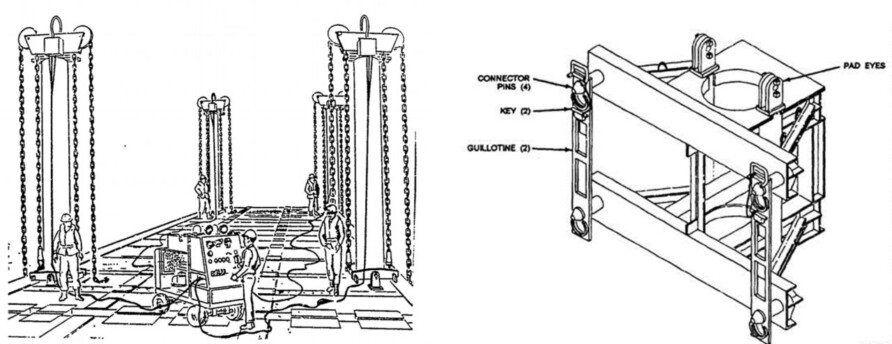
The ELCAS pier head is simply another row of causeway modules.
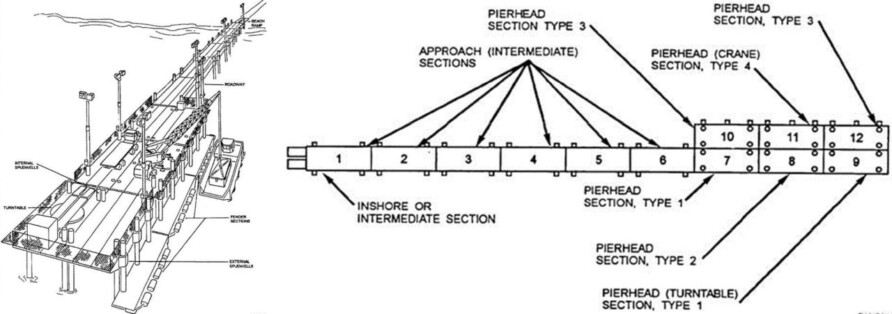
A fender string was installed to resist berthing forces and provide some measure of the stand-off that allowed the 140-tonne crawler crane to lift containers from the lighter to an awaiting truck and trailer.
The piles used for the fender string are pointed instead of hollow to allow them to be driven deeper than the normal piles. Because the pier head was not wide enough to allow a truck to turn the 180 degrees needed a motorised turntable at the seaward end of the pier head was used, ingenious, I think.

At the beach end, a pair of ramps were used to transition from the pier causeway to the beach.
The main problem with the original ELCAS was that because the causeway sections and piles had to be assembled on the water before jacking up, the whole thing was very susceptible to wind and waves, limiting the construction sea state.
It was also very labour-intensive and, therefore, not quick to install. Because the deck was frequently overtopped by waves it was wet and hazardous when operating cranes.
Recognising these shortcomings and because of the physical condition of the ELCAS stock, a decision was made to replace it, the new system coming into service, after several contract issues, in the mid-nineties. Instead of jacking floating modules out of the water, ELCAS-M uses a cantilever method to build out from the beach, without the deck modules touching the water, and thus, practically immune from wave conditions.
Many alternatives were proposed, and some initial testing was conducted, these included a high wire transfer and aerostat system, but neither was adopted. First used in operations during the 2003 operation to invade Iraq, the ELCAS-M was used to augment an existing Kuwaiti naval base, providing additional loading and unloading capacity.
Apart from the method of construction, the ELCAS-M design was not that much of a change from ELCAS.
The beach ramps are grounded into an excavated area above the high water mark called a ‘duck pond’ 9 meters wide by 8 meters long.
The 40-foot by 8-foot ISO container-sized modules are supported on 2-foot diameter hollow steel piles that are driven in during construction as the causeway is assembled from the beach to the sea.
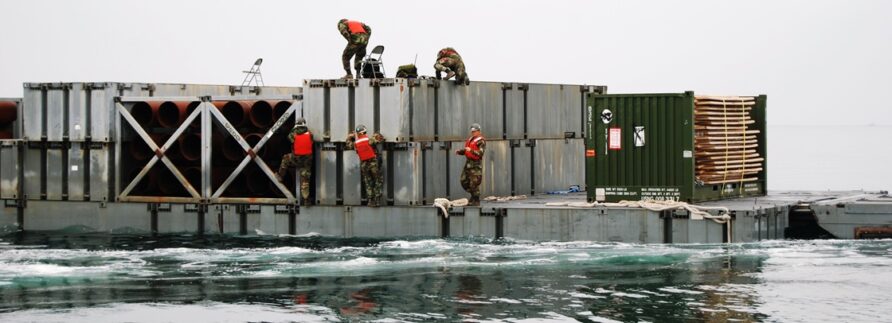
The piles are driven in sequence and modules are attached until the required length is achieved. Individual piles are 30 feet (ca. 9 m) long and welded together as they are driven, usually between 10m and 12m in depth.
Softer soil conditions will require longer piles to be used, in Kuwait, for example, many had to be 90 feet (ca. 27 m) long to achieve sufficient load-bearing strength.
Two pile drivers are used, one driving and one positioning. The full ELCAS-M system requires 193 piles.
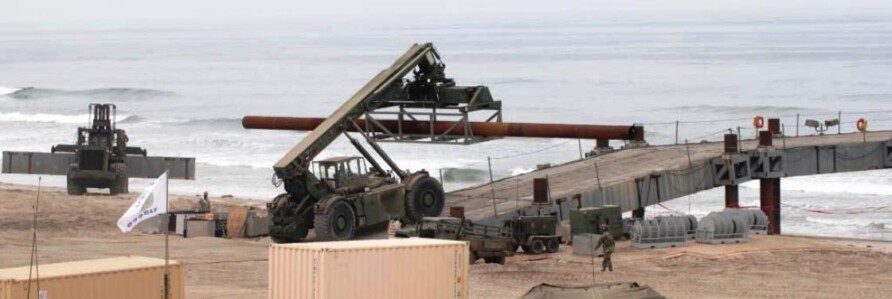
To accommodate two-way vehicle traffic, the pier is 24 feet (ca. 7 m) wide. When the piles are driven to the correct depth, they are pinned to the module and cut off flush to avoid interfering with traffic and crane operations.
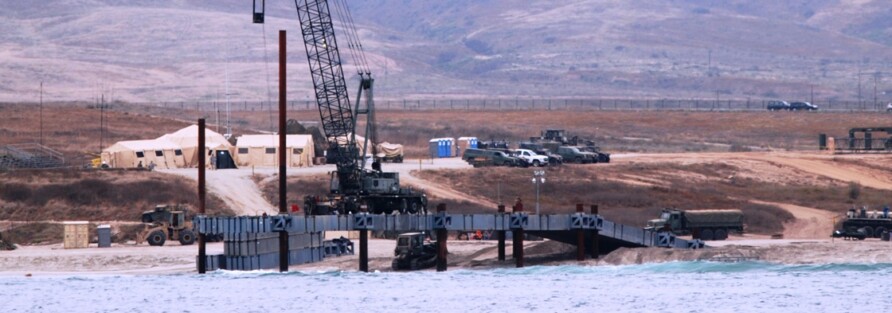
The pier head is wider to accommodate two 200-tonne cranes and two turntables that allow trucks to be turned within their diameter, which negates the need for vehicles to reverse along the full length of the pier.
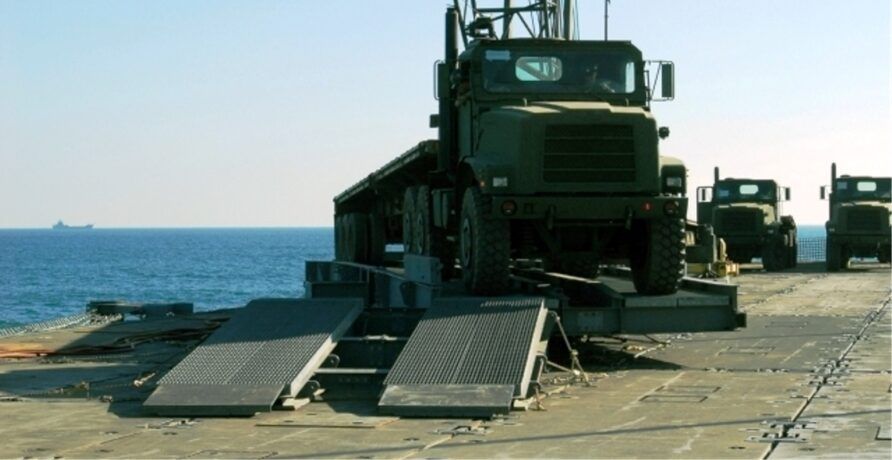
Lighting is also installed to allow 24×7 operations, together with safety restraints and power generation (total 260kW split between 4 generators). It can be built out to a maximum length of 915m and takes on average between 7 and 14 days to build, depending on pier length.
In optimal conditions, the maximum stated throughput is 370 TEU per 24-hour period, or about 15 per hour.
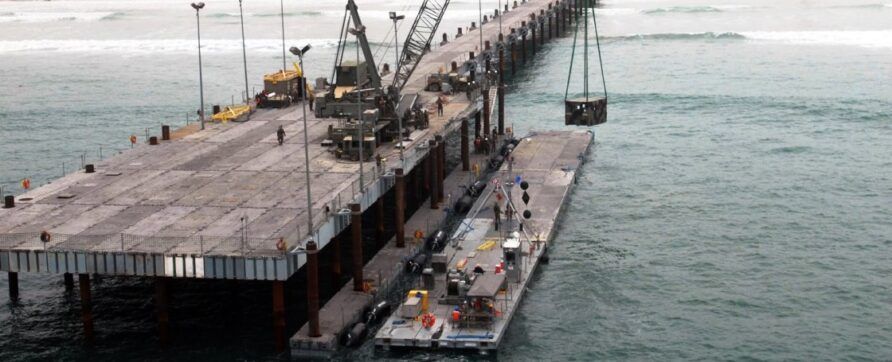
It is worth re-emphasising, that the build sequence is to land the components on the shore using a combination of landing craft and barges; the pier is built out from the beach to the sea.
The fender strings shown above alleviate some lateral forces between ELCAS and the lighter, they are the same size as normal ELCAS modules but only one wide. Elevating the pier head.
It should also be noted that the ELCAS-M system is not designed to accommodate large ships but lighters, small logistic support vessels, and pontoons/barges.
The Lightweight Modular Multi-purpose Spanning Assembly (LMMSA) was tested in 1990 to interface ELCAS with a floating RORO discharge platform.
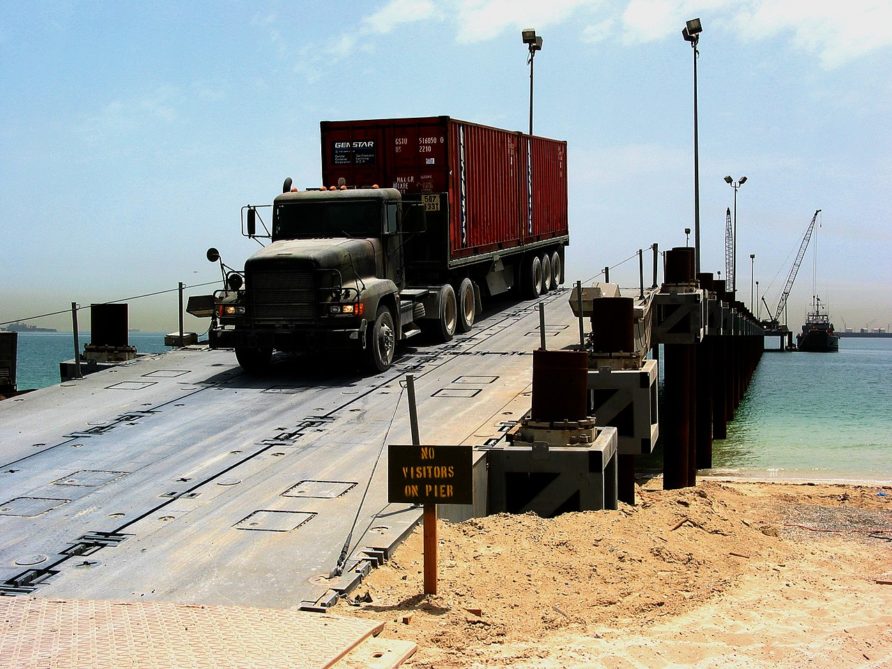
This video provides an excellent overview
Nothing about ELCAS-M is not impressive, but it is not without a few downsides and is completely out of range for the MoD.
The first is simply the resources used to build it, well beyond the RE and RLC given other competing requirements. At 6m depth, it can only accommodate smaller vessels and lighters. RORO cargo is not offloaded except by sling. Because it can only use piles to support the pier deck, it has to be sand and clay.
ELCAS-M requires the landing of the components before construction can start, this is time-consuming and is limited to a beach. It also requires a lot of MHE and construction equipment. ELCAS-M needs 7 marshalling areas for staging, storage, generators and other requirements.
Because the modules are no larger than an ISO container, they are strategically deployable but require a great deal of handling in use. Throughput is a difficult factor to quantify, but several exercises have proven the stated throughput to be very optimistic.
Although both sides of the pier can be used and the pier is wide enough for two-way traffic, the means of offloading containers is relatively slow, manually connecting slings and spreader bars to container twist locks. No automatic spreaders are used. High winds slow offload severely.
As a whole system, the need for containers to be double-handled (ship to lighter) decreases actual throughput significantly. Finally, when installed, ELCAS-M is very resistant to wind, wave, and tide but building and operation are limited by sea state, current velocity and the wind. Manoeuvring lighters into position and crane pendulation make offload operations hazardous.
It’s still bloody amazing, though.

